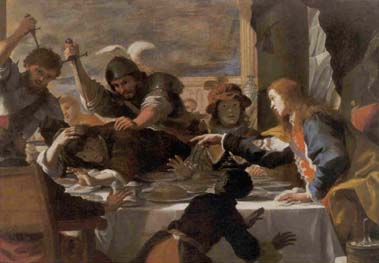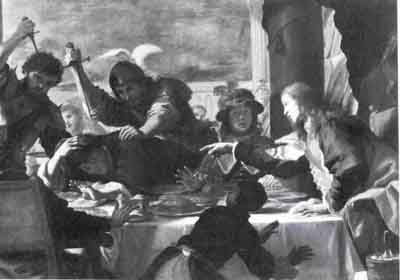
Annual Bulletin 1, 1977-1978
Home
Français
Introduction
History
Annual Index
Author &
Subject
Credits
Contact


Mattia Preti: The Feast of Absalom
by John T. Spike*
Article en français
Pages 1 | 2
| 3 | 4
| 5 | 6
*This article presents certain researches undertaken for my dissertation-in-progress, "Mattia Preti, II Cavalier Calabrese," to be submitted to the Department of Fine Arts, Harvard University. My studies abroad have been made possible by Harvard University Travelling Fellowships. I would like to express my gratitude to Professor Sydney J. Freedberg, who read my manuscript and suggested emendations. Any errors contained herein are the author's responsibility solely.
When the banquet guests had been made merry with wine, their host signalled his assassins to murder his half-brother. Thus did Absalom, son of King David, punish Amnon for the rape of his sister Tamar. This Old Testament story (II Samuel 13:28) is the subject of an important Italian Baroque painting by Mattia Preti (1613-1699), called "II Cavalier Calabrese," acquired in 1977 by the National Gallery of Canada (see cover detail, frontispiece and fig.
1). (1)
The Feast of Absalom was painted by
Preti about 1665, when he was living on the island of Malta and engaged
in the decoration of the great vault of the Conventual Church of the Knights
of St John. Mattia Preti was then at the peak of his artistic prowess and
fame. His humble origins in Calabria notwithstanding, in 1661 Preti had
been elevated to a Knighthood of Grace in the Sacred Military Order of
St John of Jerusalem, Rhodes, and Malta, whose knights represented the
noblest families of Europe.
Preti seems never to have left Malta between his
arrival in 1661 and his death in 1699, but he continued to execute commissions
for scores of patrons throughout Italy. By far the most receptive city
was Naples, where Preti had worked from 1657 to 1660 and where he had
made an enduring impression. Preti earned a particular reputation for his
skill in depicting the violent themes so favoured by the Neapolitans, as
in this Feast of Absalom.
We know from the lengthy biography of Preti in Bernardo De Dominici's
Vite dei pittori...Napoletani (Naples: 1742-1743)
that the private collections of Naples abounded with paintings by Il Cavalier
Calabrese. Most of the paintings with Neapolitan provenances can be shown,
on the basis of style, to postdate Preti's departure to Malta. De Dominici
describes in detail the Ottawa Feast of Absalom when it hung in
the palace of Don Antonio Caputo, President of the Summaria of Naples and
a great benefactor of Preti's:
In the other painting he showed the fearful scene at the Feast where Absalom caused Amnon, who had violated his sister Tamar, to be put to death. A wonderful part of it is the movement of Absalom, rising from his chair at one side of the painting, his left hand on the table and with his right directing the killing of his incestuous brother Amnon. The latter, terror-struck and pressed by his assailants, throws himself on the table, his hands apart, with a face full of fear, seeking to escape the death that is already upon him. Next to Absalom, between them in fact, is seated Tamar, with a fanciful bonnet adorned with feathers and jewels, pale and astonished at the sudden drama. The other figures draw back in astonishment. All in all, everything is terror and horror. (2)It is doubtful that any present-day viewer of Preti's picture is horrified by the scene. This is not so much hard-heartedness on our part as the style in which Preti has chosen to depict this story. The intrusion of tragedy has not dimmed the splendour of the occasion; the profusion of colours is nothing less than elating.
Although renowned as a master at representing psychological drama, Preti's intention here must have been to delight the spectator with the excitement of breathtaking action rather than to dismay him with pathos. Thrust into the light are the physical motions of pointing, stabbing, fleeing. The facial expressions of ferocity, shock, and surprise are muted in shadow. Only Absalom stands in the full light. His exuberant dress - the blue puffed sleeves, orange waistcoat, golden cloak - becomes the primary focus of attention.
By plunging all the principal figures save Absalom into shadow, Preti accentuates the two-dimensional effect of their shapes as seen against the lighter backdrops of table, sky, and architecture. The point of view is low, restricting our knowledge of the setting to fragments glimpsed under arms or between heads. Preti alternates light and dark planes and models his forms just enough to ensure that their spatial relationships and essential volumes are never ambiguous. But by daring to bring the shadows so close to apparent flatness (as in the silhouette of the African boy' s right hand, given relief only by a touch of light gray at its tip) and by bold overlappings, Preti fractures his figures into pictorial elements of nearly equal importance to the whole decorative effect, whatever their role in the narrative.
The disposition of forms in an excited overall pattern and the concern for immediate decorative values are characteristic of Late Baroque style, the transition between mid-century High Baroque and eighteenth-century Rococo. High Baroque figures have individualized features and psychologies and are interrelated within a continuous, receding space. The actors' identities in a Late Baroque picture are generalized to a uniformly handsome type to minimize any distraction from the decorative ensemble. Their discrete physical volumes are relatively less stressed.
Painted c. 1665, as we shall demonstrate below, the Feast of Absalom was one of the first essays in Late Baroque style. Preti is recognized as an innovator in the transition from High Baroque to Late Baroque. His boldest ventures in this idiom occurred between 1658 and 1666, with isolated reinvestigations made in later years. He seems to have been drawn in new directions by the pictorial problems posed by the cycle of ten paintings he executed for the ceilings of the nave and transept of San Pietro a Maiella, Naples, between 1657 and February 1659. (3)
Next Page | decorative value of the ensemble
1 | 2 | 3 | 4 | 5 | 6
Annual Index | Author & Subject | Credits | Contact
This digital collection
was produced under contract to Canada's Digital Collections program,
Industry Canada.
"Digital
Collections Program, Copyright
© National Gallery of
Canada 2001"